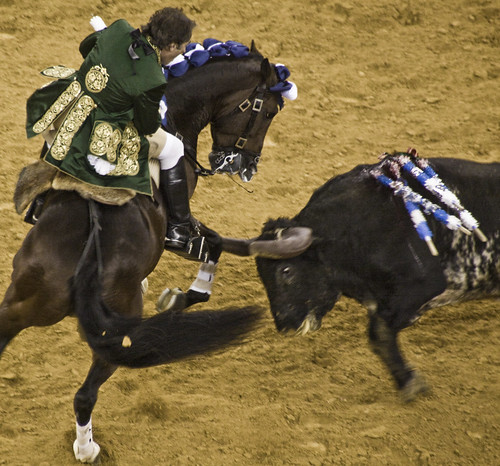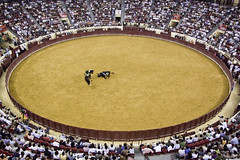One part rodeo, one part gladiator

Portuguese bullfights differ from those in other countries in two major ways.
First, the star of the show is not the matador, but a horseman bullfighter, costumed as an 18th-century nobleman, with a plumed hat and embroidered coat.
Second, and most importantly, the bull is never killed in the ring thanks to a decree made by the Marques de Pombal in the 18th century.
The latter seemed to make the idea of attending a bullfight a bit more palatable, so that’s how Jen and II found ourselves at the Campo Pequeno in Lisbon at 10pm at the last event of the season.
Outside the venue, a group of folk dancers competed for attention with a group of protesters who were trying to drown out the music with airhorns and cowbells. Inside, we climbed the stairs to the second balcony and took our seat in the first row, which offered the best view of the action, and cost 17.50€ ($26).
We were joined by Peter, a Danish tourist who came by himself, leaving his wife and kids back at the hotel.
The principle characters paraded into the ring, led by the forcados, then the matadors and finally the caveleiros. After the introduction, the bull is ushered into the ring and the battle begins.
>Bullfighting originated as a military training exercise for both man and horse, building dexterity and agility as they avoided the horns of the angry bull. These days, the horsemen display their skill by guiding the horse left, right, forward and back as the bull (with his horns filed down) chases from behind. The closer to the bull the caveleiro is, the bigger the applause when he finally “escapes.”
The barbaric part comes when the cavaleiro charges the bull with a bandarilha (dart) and drives it into the bull’s back. With each successive pass, the dart gets shorter and shorter, which increases the risk to the horse and the horseman. Meanwhile, the bull gets increasingly angrier and weaker at the same time.
 When the cavaleiro is finished showing off his bravado, a group of eight men charge the bull and the frontman flings himself onto the front of the enraged charging bull, while the other men work on slowing the bull down. It looks pretty comedic, but the danger is high.
When the cavaleiro is finished showing off his bravado, a group of eight men charge the bull and the frontman flings himself onto the front of the enraged charging bull, while the other men work on slowing the bull down. It looks pretty comedic, but the danger is high.
Finally, a group of cows are paraded into the ring and the bull follows them out. Then the process is repeated with another bull and a new cavaleiro.
In the end, I left with no desire to ever see another bullfight (as expected). It just wasn’t a fair fight. Sure, it was a cultural experience, but then again, so is NASCAR, and I have no plans to attend a race anytime in the near or distant future.
If I were the Marques de Pombal, I would have made another decree. I would ask that the bulls be “marked” with paint or velcro darts instead of causing real harm to the animals.

Write a Reply or Comment